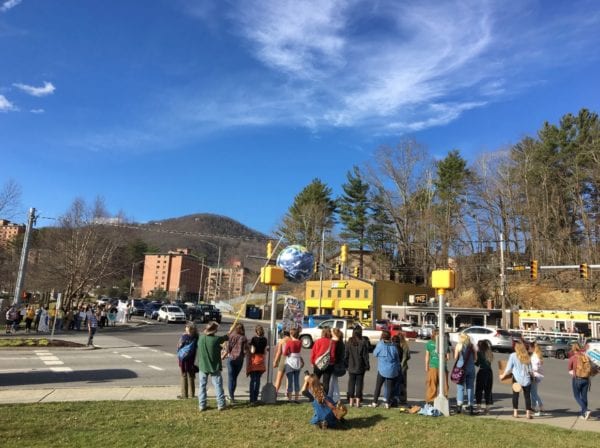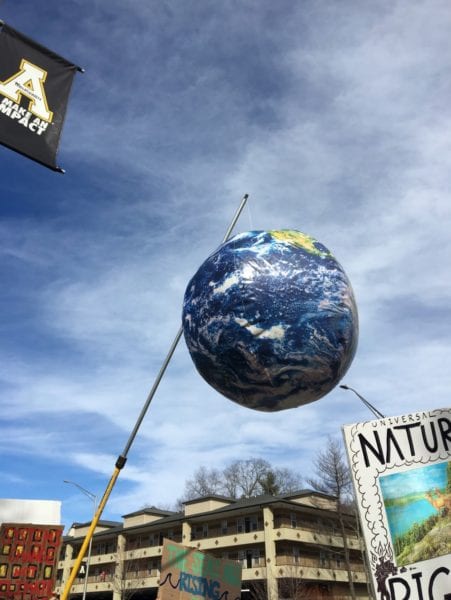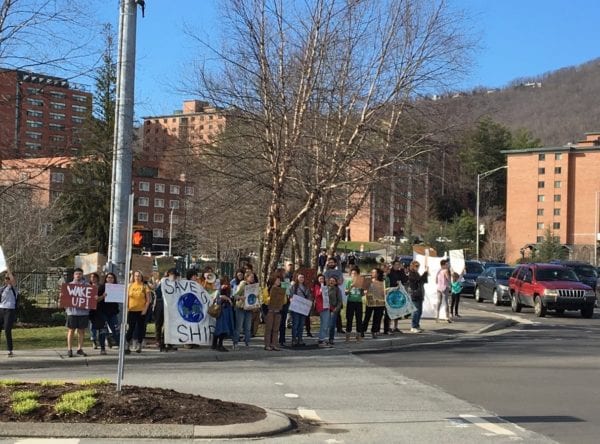
By Joe Wiswell
Last Friday climate change activists flooded through downtown Boone waving signs and chanting “Climate action! Climate justice!” and “Our lives are not for sale!” They converged on the intersection of Blowing Rock Road and Rivers Street, where they chanted slogans and waved at passing cars. Many of the cars seemed delighted to see the protesters and honked their horns to show their support.

Maggie Rumley, an App State student and organizer of the protest said, “today is all about collective action and making our voices loud for what we care about and speaking up for the planet and the people and for our future.” This action brings attention to an issue that has received little notice in the U.S., and it is a sign that public attention might be shifting toward climate change. Last Friday’s protest comes as momentum is building behind local, national, and international climate justice movements.
Last Wednesday, the ASU student senate voted unanimously to support a proposal to have the university go carbon neutral by 2025. The Friday march celebrated that victory. Devin Mullins, an App State freshman and student senator who helped write and pass the proposal, spoke at a rally before the march about the dangers that climate change poses for young people’s futures and need for ambitious action now, before further damage is done to the climate.
The carbon neutrality proposal was written by the Appalachian Climate Action Collective, a group that formed last October in response to a UN Intergovernmental Panel on Climate Change (IPCC) report that stated that global warming of more than 1.5° Celsius would be disastrous for Earth’s ecological systems and bring massive human suffering. This was a blow to the current international consensus, which states that global warming should be kept to 2°C. However, if business as usual continues, experts agree that the world will blow past even the 2°C mark and will warm by at least 3° or 4℃ degrees Celsius, possibly more. While there is no “safe” amount of warming, every fraction of a degree has massive and unpredictable effects on the delicate balance of life of Earth. In order to limit warming to 1.5°C, drastic, though affordable and feasible, actions must be taken immediately.
App State students were also joined by middle and high school students, part of a global trend where very young people are stepping up to demand serious action on climate change. You don’t need a PhD in climate science to understand the basic facts of the issue: climate change presents a serious, perhaps existential, problem for life on Earth, and the world’s political leaders have done little to solve it. Instead, young people have begun to show leadership about this crisis. Zea Marty, a local eighth-grader, spoke at the rally about the 1.5 degree warming target and the need to take action.
Many of the young people at the march have been inspired by Greta Thunberg, a 16 year old Swedish environmental activist who started leaving school every Friday last year in order to sit in front of the Swedish Parliament and demand action on climate change. Thunberg has quickly achieved international renown for the clarity and strength of her stance on climate change. She was recently nominated for a nobel peace prize. In her TED Talk she explains why she is striking from school, saying that “some people said I should be in school instead, some people said I should study to become a climate scientist so that I can ‘solve’ the climate crisis, but the climate crisis has already been solved, we already have all the facts and solutions, all we have to do is to wake up and change. And why should I be studying for a future that soon will be no more, when no one is doing anything whatsoever to save that future?”
Since it is young people who will have to live in the world we are currently creating, it only makes sense that they would be on the front lines to make sure that that world is a good one. As App State student Sydney Blume said, “The youth are rising, and there’s a global movement and we’re one piece of that!”
The march raises many questions. One of the main ones is simply why global leaders have not yet taken serious action to curb climate change, even though we have understood its dangers for decades. There is not an easy answer to that question, but much of the answer likely stems from the fact that in today’s world power is largely a result of an institution’s ability to use and control oil. Another important question is, given the short timeline that climate justice activists have to work with, whether growing climate movements will be able to muster the political power to demand significant changes before it is too late. Renowned writer and environmentalist Amitav Ghosh has suggested that in order to respond quickly, climate activists will have to get religious organizations, and their considerable resources, to help with the struggle.



You must be logged in to post a comment.